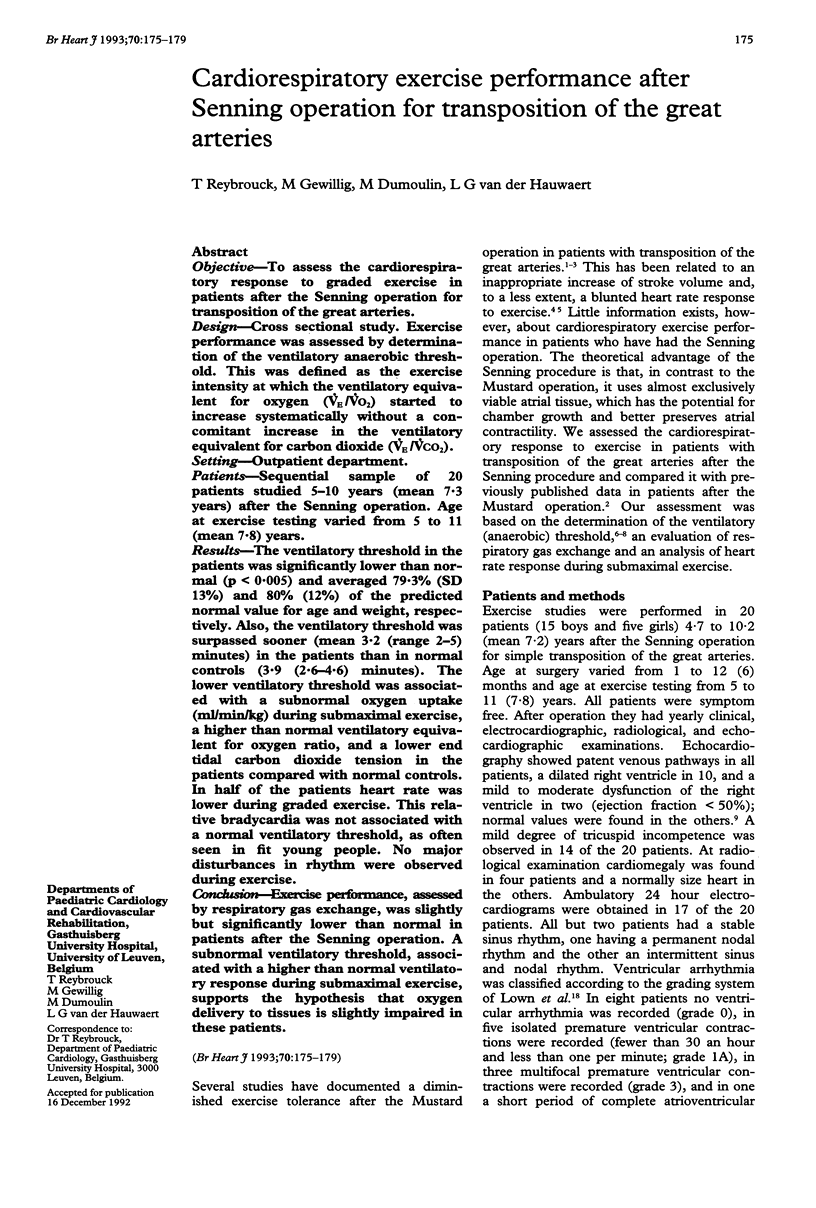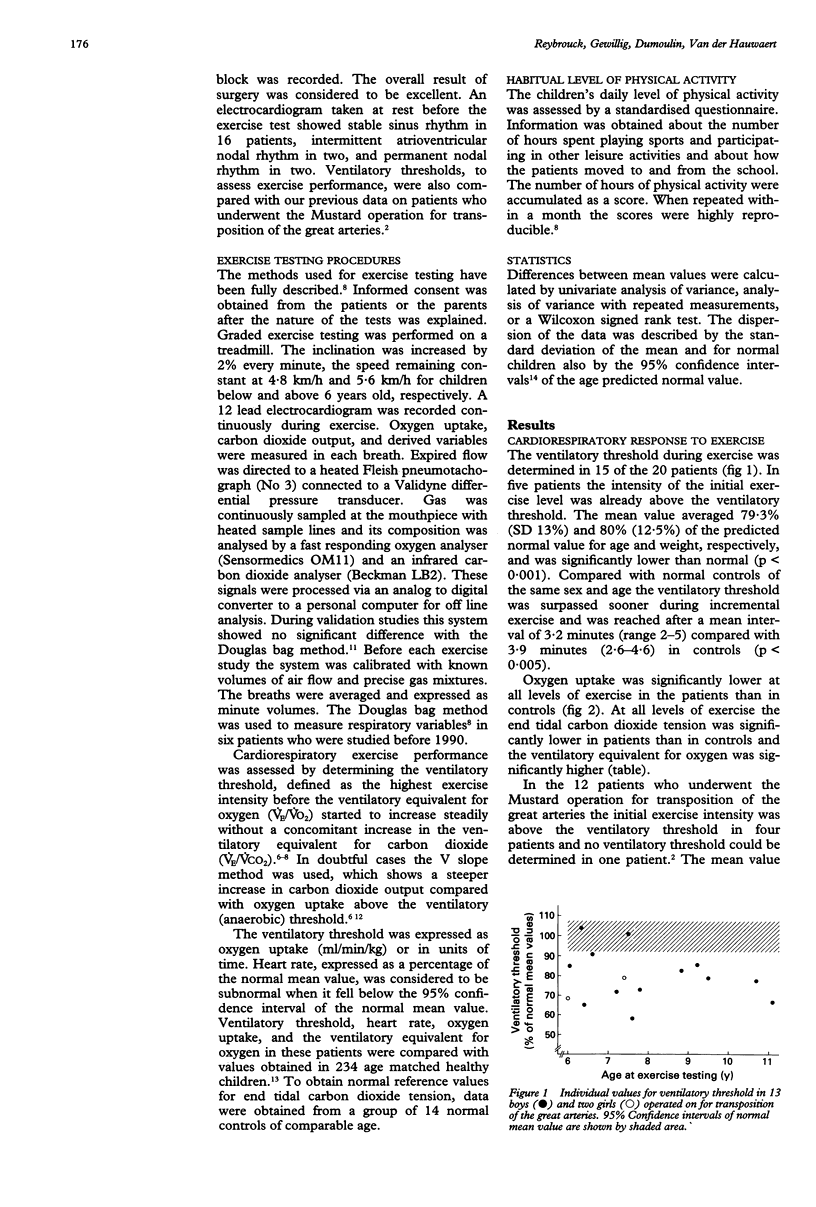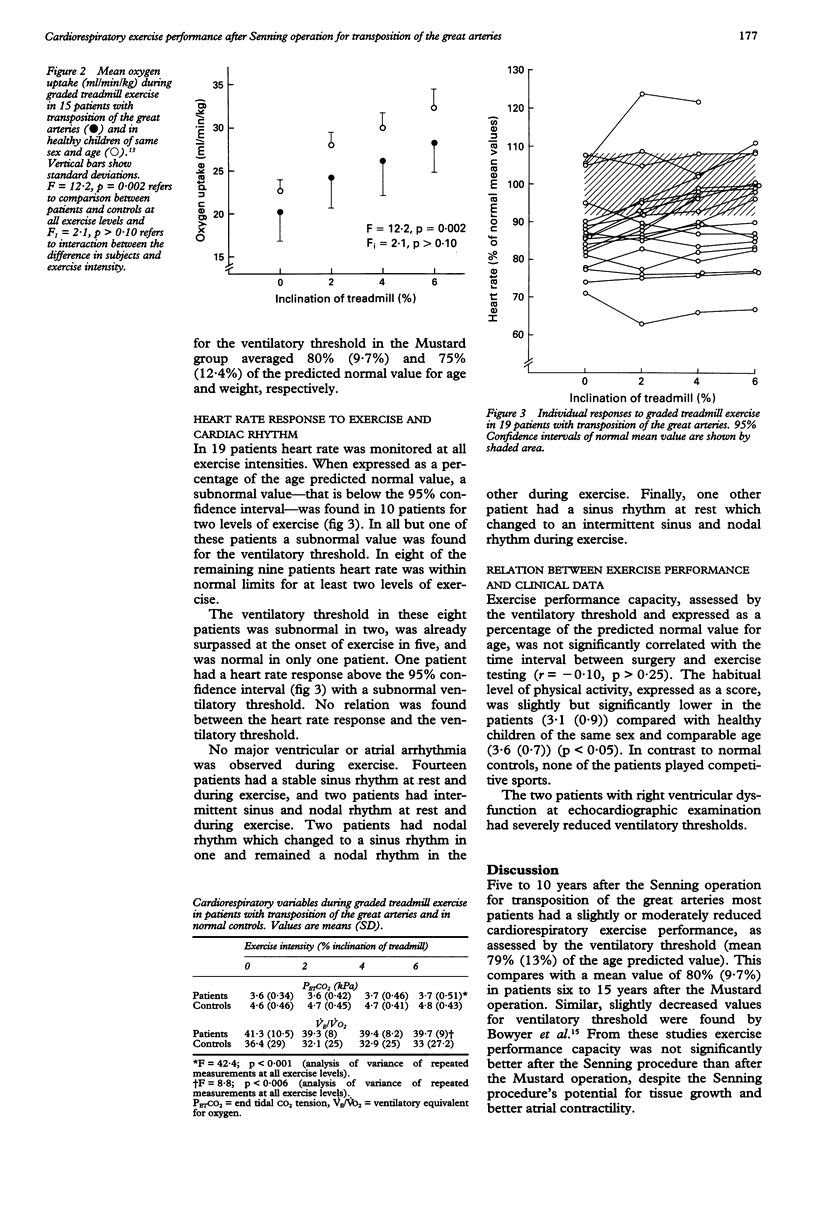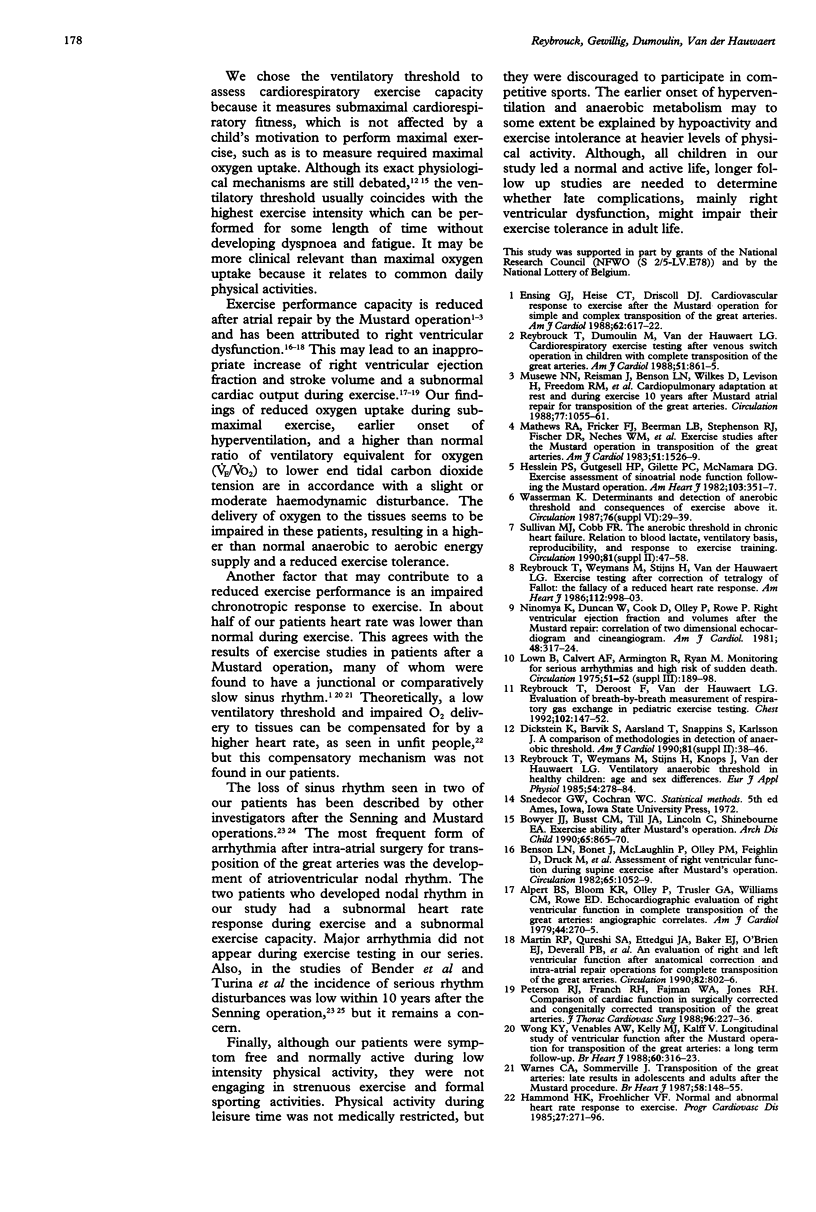Abstract
OBJECTIVE--To assess the cardiorespiratory response to graded exercise in patients after the Senning operation for transposition of the great arteries. DESIGN--Cross sectional study. Exercise performance was assessed by determination of the ventilatory anaerobic threshold. This was defined as the exercise intensity at which the ventilatory equivalent for oxygen (VE/VO2) started to increase systematically without a concomitant increase in the ventilatory equivalent for carbon dioxide (VE/VCO2). SETTING--Outpatient department. PATIENTS--Sequential sample of 20 patients studied 5-10 years (mean 7.3 years) after the Senning operation. Age at exercise testing varied from 5 to 11 (mean 7.8) years. RESULTS--The ventilatory threshold in the patients was significantly lower than normal (p < 0.005) and averaged 79.3% (SD 13%) and 80% (12%) of the predicted normal value for age and weight, respectively. Also, the ventilatory threshold was surpassed sooner (mean 3.2 (range 2-5) minutes) in the patients than in normal controls (3.9 (2.6-4.6) minutes). The lower ventilatory threshold was associated with a subnormal oxygen uptake (ml/min/kg) during submaximal exercise, a higher than normal ventilatory equivalent for oxygen ratio, and a lower end tidal carbon dioxide tension in the patients compared with normal controls. In half of the patients heart rate was lower during graded exercise. This relative bradycardia was not associated with a normal ventilatory threshold, as often seen in fit young people. No major disturbances in rhythm were observed during exercise. CONCLUSION--Exercise performance, assessed by respiratory gas exchange, was slightly but significantly lower than normal in patients after the Senning operation. A subnormal ventilatory threshold, associated with a higher than normal ventilatory response during submaximal exercise, supports the hypothesis that oxygen delivery to tissues is slightly impaired in these patients.
Full text
PDF




Selected References
These references are in PubMed. This may not be the complete list of references from this article.
- Alpert B. S., Bloom K. R., Olley P. M., Trusler G. A., Williams C. M., Rowe R. D. Echocardiographic evaluation of right ventricular function in complete transposition of the great arteries: angiographic correlates. Am J Cardiol. 1979 Aug;44(2):270–275. doi: 10.1016/0002-9149(79)90316-3. [DOI] [PubMed] [Google Scholar]
- Bender H. W., Jr, Stewart J. R., Merrill W. H., Hammon J. W., Jr, Graham T. P., Jr Ten years' experience with the Senning operation for transposition of the great arteries: physiological results and late follow-up. Ann Thorac Surg. 1989 Feb;47(2):218–223. doi: 10.1016/0003-4975(89)90272-5. [DOI] [PubMed] [Google Scholar]
- Benson L. N., Bonet J., McLaughlin P., Olley P. M., Feiglin D., Druck M., Trusler G., Rowe R. D., Morch J. Assessment of right ventricular function during supine bicycle exercise after Mustard's operation. Circulation. 1982 Jun;65(6):1052–1059. doi: 10.1161/01.cir.65.6.1052. [DOI] [PubMed] [Google Scholar]
- Bowyer J. J., Busst C. M., Till J. A., Lincoln C., Shinebourne E. A. Exercise ability after Mustard's operation. Arch Dis Child. 1990 Aug;65(8):865–870. doi: 10.1136/adc.65.8.865. [DOI] [PMC free article] [PubMed] [Google Scholar]
- Deanfield J., Camm J., Macartney F., Cartwright T., Douglas J., Drew J., de Leval M., Stark J. Arrhythmia and late mortality after Mustard and Senning operation for transposition of the great arteries. An eight-year prospective study. J Thorac Cardiovasc Surg. 1988 Oct;96(4):569–576. [PubMed] [Google Scholar]
- Ensing G. J., Heise C. T., Driscoll D. J. Cardiovascular response to exercise after the Mustard operation for simple and complex transposition of the great vessels. Am J Cardiol. 1988 Sep 15;62(9):617–622. doi: 10.1016/0002-9149(88)90666-2. [DOI] [PubMed] [Google Scholar]
- Hesslein P. S., Gutgesell H. P., Gillette P. C., McNamara D. G. Exercise assessment of sinoatrial node function following the Mustard operation. Am Heart J. 1982 Mar;103(3):351–357. doi: 10.1016/0002-8703(82)90273-3. [DOI] [PubMed] [Google Scholar]
- Mathews R. A., Fricker F. J., Beerman L. B., Stephenson R. J., Fischer D. R., Neches W. H., Park S. C., Lenox C. C., Zuberbuhler J. R. Exercise studies after the Mustard operation in transposition of the great arteries. Am J Cardiol. 1983 May 15;51(9):1526–1529. doi: 10.1016/0002-9149(83)90670-7. [DOI] [PubMed] [Google Scholar]
- Musewe N. N., Reisman J., Benson L. N., Wilkes D., Levison H., Freedom R. M., Trusler G. A., Canny G. J. Cardiopulmonary adaptation at rest and during exercise 10 years after Mustard atrial repair for transposition of the great arteries. Circulation. 1988 May;77(5):1055–1061. doi: 10.1161/01.cir.77.5.1055. [DOI] [PubMed] [Google Scholar]
- Ninomiya K., Duncan W. J., Cook D. H., Olley P. M., Rowe R. D. Right ventricular ejection fraction and volumes after mustard repair: correlation of two dimensional echocardiograms and cineangiograms. Am J Cardiol. 1981 Aug;48(2):317–324. doi: 10.1016/0002-9149(81)90613-5. [DOI] [PubMed] [Google Scholar]
- Peterson R. J., Franch R. H., Fajman W. A., Jones R. H. Comparison of cardiac function in surgically corrected and congenitally corrected transposition of the great arteries. J Thorac Cardiovasc Surg. 1988 Aug;96(2):227–236. [PubMed] [Google Scholar]
- Reybrouck T., Deroost F., Van der Hauwaert L. G. Evaluation of breath-by-breath measurement of respiratory gas exchange in pediatric exercise testing. Chest. 1992 Jul;102(1):147–152. doi: 10.1378/chest.102.1.147. [DOI] [PubMed] [Google Scholar]
- Reybrouck T., Dumoulin M., Van der Hauwaert L. G. Cardiorespiratory exercise testing after venous switch operation in children with complete transposition of the great arteries. Am J Cardiol. 1988 Apr 1;61(10):861–865. doi: 10.1016/0002-9149(88)91080-6. [DOI] [PubMed] [Google Scholar]
- Reybrouck T., Weymans M., Stijns H., Knops J., van der Hauwaert L. Ventilatory anaerobic threshold in healthy children. Age and sex differences. Eur J Appl Physiol Occup Physiol. 1985;54(3):278–284. doi: 10.1007/BF00426145. [DOI] [PubMed] [Google Scholar]
- Reybrouck T., Weymans M., Stijns H., Van der Hauwaert L. G. Exercise testing after correction of tetralogy of Fallot: the fallacy of a reduced heart rate response. Am Heart J. 1986 Nov;112(5):998–1003. doi: 10.1016/0002-8703(86)90312-1. [DOI] [PubMed] [Google Scholar]
- Vanhoutte P. M., Shimokawa H. Endothelium-derived relaxing factor and coronary vasospasm. Circulation. 1989 Jul;80(1):1–9. doi: 10.1161/01.cir.80.1.1. [DOI] [PubMed] [Google Scholar]
- Wong K. Y., Venables A. W., Kelly M. J., Kalff V. Longitudinal study of ventricular function after the Mustard operation for transposition of the great arteries: a long term follow up. Br Heart J. 1988 Oct;60(4):316–323. doi: 10.1136/hrt.60.4.316. [DOI] [PMC free article] [PubMed] [Google Scholar]


